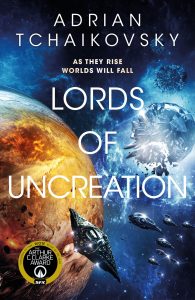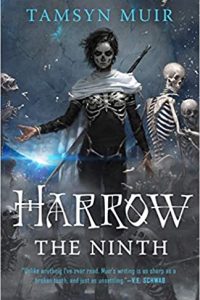Russell Letson Reviews Lords of Uncreation by Adrian Tchaikovsky
 Lords of Uncreation, Adrian Tchaikovsky (Orbit 978-0316705929, 624 pp, $29.00, hc) May 2023. Cover by Steve Stone.
Lords of Uncreation, Adrian Tchaikovsky (Orbit 978-0316705929, 624 pp, $29.00, hc) May 2023. Cover by Steve Stone.
Lords of Uncreation is the third entry in Adrian Tchaikovsky’s Final Architecture sequence that began with Shards of Earth and Eyes of the Void, which introduced a menagerie of alien civilizations living and dead, allies and opponents of all species, and a galactic history of interstellar warfare, ruined worlds, and refugees on the run from inscrutable, unstoppable planet-killers. Which means the series is probably best seen as space opera, but with any number of extensions bolted onto that sturdy chassis. The result is a three-ring-circus extravaganza, juggling flaming chainsaws, kittens, and Fabergé eggs while pedaling a unicycle backwards across a pool of hungry crocodiles.
The books combine the cosmic vision of Olaf Stapledon and the cosmic horror of H.P. Lovecraft (or William Hope Hodgson), plus cross-cultural encounters, and adventures of the military and picaresque kind, along with other items from the Big Box of Narrative Components. But then, this is the omnivorous SF category we’ve come to call New Space Opera, a fictional environment encompassing deep galactic history, vanished civilizations, enigmatic aliens, metaphysical mysteries, world-saving (or destroying) McGuffins, monstrous monsters, gigantic battles, titanic devices (infernal and miraculous), and posthuman/nonhuman heroes and villains. Among other items of interest and amazement.
That Lovecraftian vibe is foregrounded in this climactic volume, though it has played a significant part from the beginning. Interstellar travel through ‘‘unspace’’ is so harrowing that it can drive travelers to suicide, thanks to the travelers’ sense that they are alone with a horrid, unseen, hostile presence, so everyone except Intermediaries (extensively and painfully altered navigators) travels sedated. And from unspace emerge the Architects, gigantic, relentless entities that reshape inhabited worlds into planet-size sculptural constructions. The first two volumes establish and elaborate the ways that a multispecies alliance (in which humankind is a junior but not insignificant member) manages to push back against the Architects. But ‘‘push back’’ is not the same as ‘‘defeat’’ or ‘‘eliminate,’’ and in Lords of Uncreation the Architects are back, and the allies must decide how to locate and stop the power behind them.
A partial list of the allied forces includes the genetically engineered, all female, human-based Parthenon military culture; the Council of Human Interests (the ‘‘Hugh,’’ remnant of the much-diminished human interstellar polity); the crab-like Hannilambra; the collective-AI-mind Hivers (former tools of humankind, now independent); and the powerful and once Architect-proof multi-species Essiel Hegemony, which behaves like a cross between an empire and a religious cult.
The viewpoint characters caught up in these plot machineries include survivors of the earlier books’ exertions, including the remnants of the crew of the salvage vessel Vulture God: the physically incomplete but extensively technologically enhanced engineer Olli; the business agent-lawyer-duellist Kris; the long-instantiated Hiver AI-swarm Medvig. At the center of everything remains the unusual pairing of the independent Intermediary Idris Telemmier, who can navigate unspace awake and bare-brained and communicate with Architects; and his one-time comrade-in-arms, the Partheni soldier Solace, who feels the strain of competing loyalties to her military society and her old friend. Also returning are the caught-in-the-middle Hugh intelligence agent Havaer Mundy; some extravagantly arrogant and persistent aristocratic human bullies; and the wonderfully named, nightmarish Essiel criminal and ‘‘rebel angel’’ The Unspeakable Aklu, the Razor and the Hook, along with one of its more durable (in fact, nearly indestructible) minions.
With multiple viewpoint characters and story lines to follow (and the ever-present threat of Spoiling), even a skeletal plot summary is going to strain at the limits of this column. I can report, however, that the occasionally comic episodic-adventure feeling of the first two volumes has shifted to something darker and more desperate as the new wave of Architects turn their attentions even onto the previously immune Essiel. Old alliances are strained almost to the breaking point, and long-running tensions among competing and cooperating powers generate not only diverging notions of how to combat the Architects but whether to do so at all. One group is planning on gigantic ark-ships on which to preserve a selection of humanity (with themselves at the top of the pyramid, of course), while both the Hugh and the Parthenon hierarchy harbor restless plotters with their own agendas. Accordingly, the story line is rich with plots and counterplots, betrayals and backstabbings, realignments of loyalty, and enough big special-effects set pieces to justify the ‘‘opera’’ part of the genre label.
In the spirit of movie trailers, though, there are snippets that give the flavor of this big, complex story. When, for example, the Architects move from mere planetary reconfiguration to using their infantry-equivalent forces, whose horrors are decidedly up-close physical:
a half a dozen other appendages peeled the portal back…. What came through first was something like a woodlouse, its raised underside all gleaming killer cutlery. Behind it stalked an absurdly delicate thing on spindly gazelle legs, its head a flower of teeth.
We see quite a bit more of the Essiel, who finally condescend to offer cooperation of a sort in the shape of The Uspeakable Aklu and his ship and minions. Olli (herself dependent on a range of prosthetic appendages) is partnered with one of the Essiel’s half-human, half-alien-symbiote assassin-agents and becomes, effectively, part of the Unspeakable’s organization–and finds it oddly fitting.
Aklu was her monster…. Something about the Razor and the Hook’s life in defiance of the [Essiel] Hegemony spoke to the rebel inside her that had never agreed to live with her inbuilt limitations.
Which leaves Idris at the center of a new team of oddballs and revenge-obsessed scientists, hoping to find a way to penetrate unspace and confront the powers behind all the destruction rising from its undepths. Frodo-like in his fragility and determination, he continues his desperate, draining efforts to get to the ‘‘kraken,’’ the enemy at the (metaphorical) bottom of unspace, toward a Lovecraftian moment.
It uncoiled. Vast, sightless, lazy. Its unreal tentacles reaching up through the lightless abyss to touch him…. He felt himself in the very shadow of the Presence, sneaking past the limitless expanse of its leathery flank. And beyond it, beneath it….
The abyss gazed back at him.
The combination of space operatics, horrors nameless and all-too-physical, alien cultural encounters, eye-crossing intrigues, serviceable villains, desperate heroics, durable loyalties, and strange but satisfying transformations makes for a complex, exhilarating ride. Save the kittens, and watch out for the crocodiles.
Russell Letson, Contributing Editor, is a not-quite-retired freelance writer living in St. Cloud MN. He has been loitering around the SF world since childhood and been writing about it since his long-ago grad school days. In between, he published a good bit of business-technology and music journalism. He is still working on a book about Hawaiian slack key guitar.
This review and more like it in the September 2023 issue of Locus.
 While you are here, please take a moment to support Locus with a one-time or recurring donation. We rely on reader donations to keep the magazine and site going, and would like to keep the site paywall free, but WE NEED YOUR FINANCIAL SUPPORT to continue quality coverage of the science fiction and fantasy field.
While you are here, please take a moment to support Locus with a one-time or recurring donation. We rely on reader donations to keep the magazine and site going, and would like to keep the site paywall free, but WE NEED YOUR FINANCIAL SUPPORT to continue quality coverage of the science fiction and fantasy field.
©Locus Magazine. Copyrighted material may not be republished without permission of LSFF.








